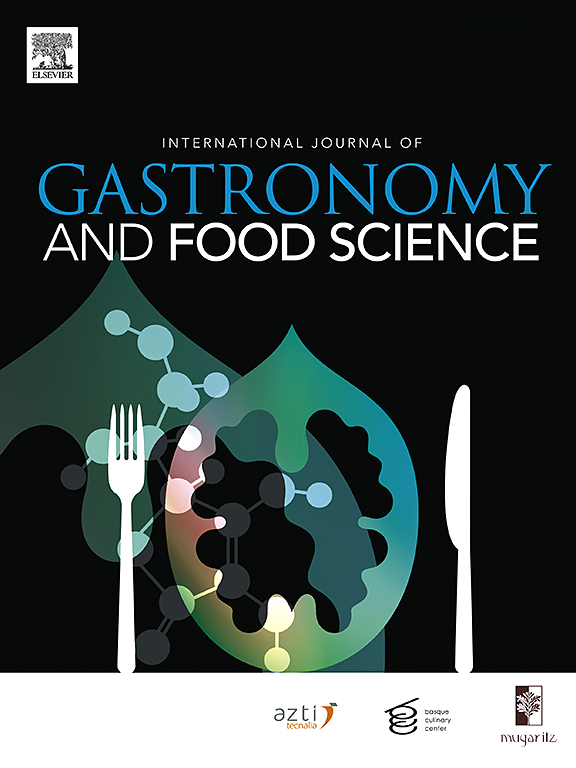Characterization of the sensory evaluation system for fermented chili pepper (Capsicum annuum L.) using GC-O-MS and sensory analysis techniques
IF 3.2
2区 农林科学
Q2 FOOD SCIENCE & TECHNOLOGY
International Journal of Gastronomy and Food Science
Pub Date : 2025-04-28
DOI:10.1016/j.ijgfs.2025.101191
引用次数: 0
Abstract
This research addresses the lack of a standardized sensory evaluation framework for Guizhou fermented chili peppers (Capsicum annuum L.). By integrating instrumental and sensory analysis techniques, we developed a sensory lexicon, sensory wheel, and predictive evaluation model. Ten representative samples from five regions in Guizhou Province were analyzed using gas chromatography-olfactometry-mass spectrometry (GC-O-MS) and sensory evaluation to assess their sensory attributes, physicochemical properties, and aroma components. Results indicate that esters and alcohols dominate the aroma profile. Principal component analysis (PCA) and partial least squares regression (PLSR) identified key variables influencing sensory quality: b∗ value, total acidity, ethyl acetate, 2-heptanol, sulfur compounds (diallyl sulfide, diallyl disulfide, and diallyl trisulfide), and linalool had a positive impact on sensory quality, whereas total sugar, reducing sugar, pH, and phenethyl acetate had negative effects. These findings provide a quantitative framework for evaluating the sensory quality of Guizhou fermented chili peppers.
利用GC-O-MS和感官分析技术对发酵辣椒感官评价体系进行表征
本研究解决了贵州发酵辣椒(Capsicum annuum L.)缺乏标准化感官评价框架的问题。通过整合仪器和感官分析技术,我们开发了一个感官词汇、感觉轮和预测评估模型。采用气相色谱-嗅觉-质谱(GC-O-MS)和感官评价相结合的方法,对贵州省5个地区的10种代表性样品进行了感官属性、理化性质和香气成分的分析。结果表明,酯类和醇类主导了香气谱。主成分分析(PCA)和偏最小二乘回归(PLSR)确定了影响感官质量的关键变量:b *值、总酸度、乙酸乙酯、2-庚醇、硫化合物(二烯丙基硫醚、二烯丙基二硫醚和二烯丙基三硫醚)和芳樟醇对感官质量有积极影响,而总糖、还原糖、pH和乙酸苯乙酯对感官质量有负面影响。研究结果为评价贵州发酵辣椒感官品质提供了定量框架。
本文章由计算机程序翻译,如有差异,请以英文原文为准。
求助全文
约1分钟内获得全文
求助全文
来源期刊

International Journal of Gastronomy and Food Science
Social Sciences-Cultural Studies
CiteScore
5.30
自引率
10.50%
发文量
170
审稿时长
45 days
期刊介绍:
International Journal of Gastronomy and Food Science is a peer-reviewed journal that explicitly focuses on the interface of food science and gastronomy. Articles focusing only on food science will not be considered. This journal equally encourages both scientists and chefs to publish original scientific papers, review articles and original culinary works. We seek articles with clear evidence of this interaction. From a scientific perspective, this publication aims to become the home for research from the whole community of food science and gastronomy.
IJGFS explores all aspects related to the growing field of the interaction of gastronomy and food science, in areas such as food chemistry, food technology and culinary techniques, food microbiology, genetics, sensory science, neuroscience, psychology, culinary concepts, culinary trends, and gastronomic experience (all the elements that contribute to the appreciation and enjoyment of the meal. Also relevant is research on science-based educational programs in gastronomy, anthropology, gastronomic history and food sociology. All these areas of knowledge are crucial to gastronomy, as they contribute to a better understanding of this broad term and its practical implications for science and society.
 求助内容:
求助内容: 应助结果提醒方式:
应助结果提醒方式:


